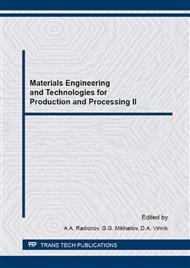p.129
p.135
p.141
p.149
p.159
p.163
p.169
p.175
p.181
Metallographic Examination of Forming Improved Mechanical Properties via Surfacing of Steel HARDOX 450 with Flux Cored Wire
Abstract:
Phase composition, defect substructure, and mechanical and tribological properties of the steel Hardox 450 surfaced with С-V-Cr-Nb-W wire are analyzed relying on procedures of transmission diffraction microscopy, mechanical and tribological methods. As a result of surfacing, wear resistance of the material is 138 – 153 times higher than that of the steel Hardox 450, and the friction factor diminishes 2 – 2.5 times. The changing dislocation substructure and phase composition of the deposited metal are analyzed in the paper. The authors have come to the conclusion that the change in analyzed properties is caused by initiation of a multiphase nanostructure. It has been revealed that its strengthening is possible due to the developing of the α-matrix martensitic pattern and a high inclusion of the volume fraction of iron-, chromium-, tungsten,- and niobium-based carbide phase. It has been ascertained in the paper that the iterative surfacing results in attenuation of the oxide phase and in the significant growth of the volume fraction inclusion of the carbide phase.
Info:
Periodical:
Pages:
159-162
Citation:
Online since:
September 2016
Authors:
Price:
Сopyright:
© 2016 Trans Tech Publications Ltd. All Rights Reserved
Share:
Citation:


